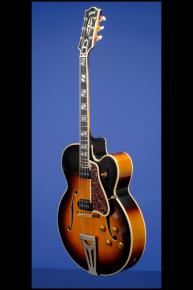"One Of The Great Aristocrats Of The Guitar World…"
1956 Gibson Super 400 CES (Sixth Model).
This early September 1956 eighteen inch-wide, full-depth archtop weighs just 7.80 lbs. and has a comfortable nut width of just under 1 11/16 inches and a scale length of 25 1/2 inches. Two-piece carved close-grain spruce top, two-piece carved curly maple back, and maple sides. A wonderful medium profile two-piece highly-flamed curly maple neck with a single mahogany center strip. Ebony fretboard with 20 original medium jumbo frets and inlaid pearl split-block position markers. The top has nine-ply binding, the back has five-ply binding, the f-holes are triple-bound, the neck is triple-bound, the headstock is multi-bound, and the fretboard has double white lines on each side. Headstock with inlaid pearl "Gibson" logo and pearl five-piece split-diamond inlay. Black laminate headstock back with pearl three-piece split-diamond inlay. Individual Kluson Sealfast tuners with tulip-shaped 'single-ring' keystone buttons. Black plastic truss-rod cover with a white border and a parallelogram on its face. Two original single-coil Alnico-V pickups with nicely balanced outputs of 8.61k and 8.48k. Multi-bound tortoise shell-like plastic pickguard with mottled plastic overlay. Four controls (two volume, two tone) plus three-way selector switch. Gold plastic bell-shaped "Bell" knobs. Later ABR-1 Tune-O-Matic retainer bridge with metal saddles on two-footed rosewood base, standard postwar Super 400 brass tailpiece with 'Varitone' control at the end. All hardware gold-plated. Orange oval label inside the bass f-hole, with the model "S-400-CES" written in black ink and the serial number "A 23912" stamped in black. Inside the treble f-hole the FON (factory order number) "V 4813 2" is stamped in black. Although the ABR-1 bridge is of a later type, it was most likely fitted to replace a 'preset' rosewood bridge which was often still used on this model through 1956. Apart from a few miniscule surface marks, this exceptionally rare guitar is in near mint condition. The original frets show slight wear but have plenty of life left in them. Housed in the original Gibson four-latch brown "Lifton" hardshell case with pink plush lining (8.75).
"The sixth model Super 400CES was officially offered only in the golden sunburst and natural finishes from early 1951 through half of 1960. Both finishes highlighted the spectacular wood in these early electric Super 400s, and it is rare to find a Super 400CES from this time period that has anything but the finest rim and back materials… From 1954 through mid 1958, the Super 400CES utilized the single-coil Alnico pickups, with six square Alnico-V magnets for pole-pieces. These pickups were placed in an aluminum pickup frame that rested on the top of the guitar just as the P90 pickups did. The Alnico pickups used black plastic covers with rectangular slots cut in the top for the pole pieces. A riser was also used to elevate the back pickup somewhat to place it closer to the guitar strings…" (Thomas A. Van Hoose. The Gibson Super 400. Art of the Fine Guitar).
"…around 1952, the Gibson engineers Walt Fuller and Seth Lover perfected a new pick-up currently nicknamed "Alnico" pick-up because it has six oblong Alnico V magnets placed directly under the strings… Gibson's objective with this new pick-up whose magnets were adjustable in height was to obtain a better sensitivity, and thus, a more balanced, but also a more powerful sound than with the regular single coil pick-up. The magnets of this new pick-up were stronger, being real Alnico V instead of the weaker Alnico ll or iV. On the other hand, this single coil still had 10,000 turns of number 42 wire, the most commonly used wire for high impedance guitar pick-ups.
This sophisticated conception naturally destined the "Alnico" pick-up for the most "luxurious" models of the electric line, such as the Super 400 CES, the L-5 CES and later on the Les Paul Custom or the Byrdland. However, a certain number of ES-175 models were also fitted with this unit, either on a special order basis or to accommodate the existing stock or simply to promote the latest Gibson pick-up.
Against all expectations it seems though that the more delicate tuning of the "Alnico" pick-up, compared to regular
P-90 pick-up, might have hurt its scope, as it proved to be less "popular" than perhaps Gibson had thought it would be.
This is likely the reason why a great number of L-5 CES and even a few Super 400 guitars are found today with
P-90 single coil pickup and not the "Alnico" type. It is difficult to give an accurate estimate of the proportion but it was practically half-and-half for the L-5 CES. On some guitars the equipment was "mixed" with an Alnico pick-up and a
P-90 pickup. Some L-5 CES's were also equipped at the factory with only one pick-up instead of two…
Through the years the Super 400 CES was to make itself famous in the hands of guitarists such as Kenny Burrell, Merle Travis, Larry Coryell, Louis Stewart or Eric Gale. The "L-5 CES", for its part, was adopted by the great Wes Montgomery and, for some time by George Benson, not to forget Elvis Presley's first guitarist, Scotty Moore, who used an "L-5" before switching over to a "Super 400" to lay down the basics of rock guitar!
The introduction of these two models in 1951 can be regarded as a sort of high point for the "amplified" acoustic guitar, for in 1952 an new type of purely electric guitar was to make its appearance and progressively revolutionize the market… We are speaking, of course, of the Les Paul series guitar…" (A.R. Duchossoir. Gibson Electrics, pp.50-52).
According to the Gibson shipping records, a total of 126 Sixth Model Super 400 CES Guitars were produced with the Alnico V pickups between 1954 and mid-1958. Of these 73 were finished in Golden Sunburst and 53 in Natural.
The price new in 1956 for the 'Golden Sunburst' was $650 and $675 for the 'Natural' + another $60 for the case!













